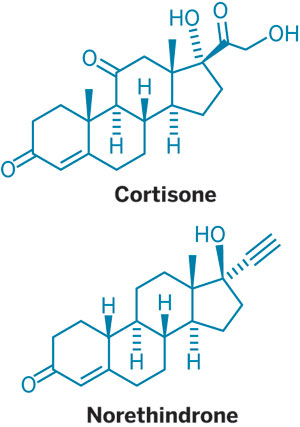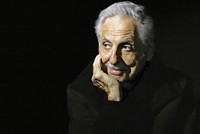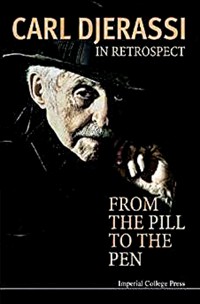Advertisement
Grab your lab coat. Let's get started
Welcome!
Welcome!
Create an account below to get 6 C&EN articles per month, receive newsletters and more - all free.
It seems this is your first time logging in online. Please enter the following information to continue.
As an ACS member you automatically get access to this site. All we need is few more details to create your reading experience.
Not you? Sign in with a different account.
Not you? Sign in with a different account.
ERROR 1
ERROR 1
ERROR 2
ERROR 2
ERROR 2
ERROR 2
ERROR 2
Password and Confirm password must match.
If you have an ACS member number, please enter it here so we can link this account to your membership. (optional)
ERROR 2
ACS values your privacy. By submitting your information, you are gaining access to C&EN and subscribing to our weekly newsletter. We use the information you provide to make your reading experience better, and we will never sell your data to third party members.
Profiles
Carl Djerassi’s Search For Home
At 90, highly celebrated chemist and author has a burning quest to belong
by Jeffrey I. Seeman, University of Richmond
October 21, 2013
| A version of this story appeared in
Volume 91, Issue 42

He has published more than 1,200 scientific papers, 350 in the Journal of the American Chemical Society.
He is a chemical “father of the Pill.”
He has published three autobiographies, one memoir, five novels, two nonfiction books, 11 plays, two collections of poetry, three collections of essays and short stories, and one art book.
He has made significant contributions, in cash and in kind, to charitable causes and artistic endeavors.
He has received the National Medal of Science and the National Medal of Technology.
He has been awarded the Priestley Medal, the first Wolf Prize in Chemistry, and many other awards, as well as 32 honorary doctorates.
He has been recognized by Austria with a postage stamp issued in his honor.
He is in constant demand as a lecturer around the world.
He will turn 90 on Oct. 29.
Yet, Carl Djerassi has never been fully satisfied.
***
Carl Djerassi has always been in a hurry, so it’s no wonder that his CV looks like the combined CVs of several people, pasted together.

As refugees from Hitler’s Nazi Austria, Djerassi, age 16, and his Viennese mother arrived penniless in the U.S. in December 1939. His Jewish father remained in Bulgaria, accurately anticipating that he was safe in his homeland. Djerassi soon wrote an entreating letter to Eleanor Roosevelt, which led to a scholarship at Tarkio College in Missouri. In his first semester in the spring of 1941, he earned spending money by giving “Inside Europe Today” Sunday lectures at local churches. After one semester at Tarkio, he transferred to Kenyon College, where in October 1942 he received an A.B. summa cum laude (premed with a major in chemistry). He was just turning 19 and already demonstrating a knack for getting his way, quickly.
A year at Ciba (1942–43) as a research chemist (and coinventor of one of the first antihistamines, tripelennamine) made clear to him that he must have a Ph.D., which he received in 1945 from the University of Wisconsin, Madison, at age 22. He completed his Ph.D. studies in just two years, having announced that intention to his adviser in an early interview.
Four more years at Ciba convinced Djerassi that the route to an academic job lay elsewhere. Disregarding the advice of many, Djerassi moved with his wife to Mexico City in 1949 as associate director of chemical research at the pharmaceutical company Syntex to work on the synthesis of cortisone from Mexican plant raw materials. Djerassi’s condition for taking the job: that all the research must be published.
In two years, he and his Mexican collaborators had 72 publications, held numerous patents, and completed the synthesis of cortisone ahead of the competition: research groups led by both R. B. Woodward and Louis F. Fieser at Harvard University and at a number of major pharmaceutical companies in the U.S. and Europe. In addition, the Syntex team achieved the first synthesis of a steroid oral contraceptive, norethindrone, which became the chemical template on which virtually all other oral contraceptives are based. This work led him to a continuing interest in population control, women’s rights, and related social issues and greatly affected his later teaching in human biology and feminist studies at Stanford University.
Djerassi’s pathway—via Mexico City in the early 1950s—to an academic position was serendipitous if not ingenious. His outpouring of publications was irresistible to one university, Wayne University in Michigan (now Wayne State University), where he stayed for eight years. In 1959, Djerassi joined William S. Johnson as Stanford’s chemistry department began its ascendancy. Again, however, Stanford had to meet several of Djerassi’s requirements, including a new chemistry building.
***
Djerassi’s 42 years at Stanford are well-trodden territory—more than 900 publications in natural products and physical methods in organic chemistry, notably chiroptical methods and mass spectrometry, as well as on applications of artificial intelligence to structure elucidation. For much of that time, Djerassi was actually only a half-time Stanford faculty member, though carrying a full-time research and teaching load. He maintained a nearly half-time industrial position, first as vice president and then president of Syntex Research (by then established in the Stanford Industrial Park, 10 minutes away from his Stanford office), then later positions as board chair at SYVA and Zoecon—companies he helped found in the same location.
***
Between 1978 and 1985, a series of cataclysmic personal events initiated a discontinuity in Djerassi’s professional life, from academic scientist to full-time author and playwright. His ambitions and lack of fulfillment would fuel that personal reinvention.

On July 5, 1978, Djerassi’s daughter, Pamela (from an early marriage that ended in divorce in 1976), committed suicide. After four days of desperate search, he found her body on his ranch on the San Francisco peninsula; he scattered her ashes there shortly thereafter.
In May 1983,“the great love of my life, Diane Middlebrook, announced that she had fallen in love with someone else, and that we were through,” Djerassi recounted in his most recent (2013) autobiography. Their breakup lasted a year. Ultimately, they reunited and were married in June 1985. The marriage continued until her death in 2007.
Two months after they were married, Djerassi was diagnosed with very serious colon cancer and underwent surgery shortly thereafter. A transition had begun.
***
“After my cancer operation,” Djerassi recalled in his first autobiography, “when the morphine-induced cloudiness had lifted, I asked myself whether I would have led a different life if 5 years earlier I had known that I would come down with cancer. It took very little reflection to answer my alter ego in the affirmative. The next question was obvious: Will I now live a different life? The short answer was ‘yes.’ ”

Djerassi closed his laboratories in 1992, though he continued his teaching; nearly aged 70, he began a new intellectual life as a novelist, playwright, and poet. He developed the genre of “science-in-fiction” and took full advantage of his experiences as a scientist, academic, and industrial chemist and administrator in his writings and plays. In memory of his daughter, he established an artist colony on his ranch, which by now has supported more than 2,000 artists. He travels almost continuously, speaking on the ramifications of separating sex from reproduction as well as on his plays and novels.
***
What traits and gifts created the Djerassi phenomenon?
Brilliance. A breadth of knowledge, intellectual curiosity, and fearlessness. Indefatigable determination. High energy, a spiral of working harder and harder. Swift efficiency. Impatience. A focus that borders on inflexibility. An unwillingness to compromise, especially when principles are at stake. A certain degree of narcissism. A tough exoskeleton, revealing no shred of self-doubt “but possessing plenty of it,” as he admits. An international heritage, highly educated parents, both physicians. Sophistication and worldliness. True to his word. Artistic. Debonair. Striking in appearance and diction. A blend of showmanship and salesmanship that can be enviable and exasperating. Charming and, with women, seductive. With fellow scientists, deeply competitive. Relentlessly preoccupied with time.
In my 1997 video documentary of him, Djerassi spoke of the value of time. “I leave little time for ‘ad hocery.’ If someone bumps into me and says, ‘Carl, let’s chew the fat,’ I am going to ask him, ‘For how long? What do you want to talk about? Why?’ Well, you know, that’s insulting. If I were on the receiving end of this, I wouldn’t like that very much, and I am aware of this. But now, I’m not going to pay the price of saying, ‘Well, I’ll throw out another hour or two hours or half hour, whatever it is,’ because that half hour, one hour, now, at this stage of my life is worth much more than what it was, let’s say, 30 or 40 years ago, and even then I was not prepared to do it.”
***
What of Djerassi’s many traits are sources of energy that drive him on?
He has written, “I was simply ambitious (too ambitious and too difficult to satisfy) all my life.”
Ambition and competition have powered much of his work. “I have practiced one-upmanship for most of my adult life—often to my detriment, a behavior still in full bloom on my 90th birthday” and the theme of his latest short-story collection.
He has an unquenchable thirst for recognition and for fulfillment. Some may differ with Djerassi’s strongly held view that “scientists have an overmastering desire for recognition by their peers. No other recognition matters.”
Djerassi has chosen to develop and share new areas of knowledge. He has often referred to himself as a “professional and intellectual polygamist.”
His curiosity and commitment to his students—more than 300 graduate students and postdocs from 49 countries—also drove his science. Ego drives his literary output, fed in part by his perennial desire to teach.“I decided on a literary gamble: to pursue fiction writing for didactic reasons.”
He also has a need to be pedagogical and to reveal who he is, a sense of homelessness, of not belonging. Djerassi searches for “heimat,” a nearly untranslatable German concept that he defines as a “feeling of expressed connection, interpersonal connections” that he lost during Nazi times.
***
For years, Djerassi has felt unappreciated within the U.S. chemical community and as evidence cites the fact that he never received certain awards and symposium invitations. He feels he “was in many respects an outsider and a maverick in American chemical circles. This really silly preoccupation with the National Organic Symposium, not being invited once during 42 years at Stanford, dwarfs even my disappointment of never having received an ACS award in organic chemistry or mass spectrometry. A refugee from Nazi times feels an outsider status much more than others.”
Djerassi says he no longer wants to be solely defined by his scientific accomplishments. Today, he also wants to be known for his literary life. He especially bristles at being defined as a “father of the Pill” because he
For a person so richly celebrated for his multitudinous contributions, could it be—like the folktale of “The Fisherman and His Wife”—that there can never be enough? In a series of e-mail interviews, I pressed Djerassi on this: “You have the Priestley, the National Medal of Science, the National Medal of Technology, the National Academy of Sciences, a fellow of the Royal Society.” He finally responded, “Let’s drop that subject, because I find it utterly embarrassing to harp on a subject which stupidly bothered me most of my professional life and of course was one of the reasons for dropping chemistry.” If we take him literally, he is saying that, regardless of his scientific output, he would always be an outsider in the chemistry community. Uncharacteristically, Djerassi may well have given up on chemistry in exchange for a metamorphosis.
Djerassi wants to be understood as a person, but at the same time, he makes that difficult. About his enormous outpouring of autobiographies and fiction, he says, “All the really important aspects—feelings, misdeeds, and virtues—about me are really only disclosed in my fiction and plays.” And, “Some fiction writers are autobiographers wearing a mask. I belong to that subset.”
Djerassi has often refused to respond directly to my questions, pointing me to his fiction instead. “It is only through my fiction and playwriting that people will learn the truth about me, assuming they are even interested.” It is an enigma. Why, then, has he bothered to write three autobiographies and a memoir? Furthermore, despite all that he has written about and of himself, Djerassi feels he is not well enough understood. Not understood, and thus not embraced. Not embraced, thus not belonging.
Advertisement
As Djerassi wrote in his most recent autobiography, “My mother threatened on numerous occasions to commit suicide—a form of emotional blackmail which eventually made it unbearable for me to respond and led to our estrangement.” Djerassi’s primary mechanism to overcome tragedy, especially that of being a refugee, is very hard work. For those of us who had uneventful childhoods, it is hard to imagine fleeing from the Nazis; becoming a refugee and thus an outsider; being separated from one’s father for 10 years during and after World War II; and coming to a strange land with a mother who, as a refugee, became somewhat unstable.
The Austrian postage stamp honoring Djerassi says “1938 vertrieben” [expelled]. In the book “What Happened to the Children Who Fled Nazi Persecution,” Gerhard Sonnert and Gerald Holton point to the “enduring trauma ... the aloneness and alienation … insecurity ... separation from family ... and ultimately anguish and achievement” of expelled refugees. They conclude, “It is the refugees themselves who pay the price. ... In the most extreme instances, they do so by making extraordinarily large contributions to society.” Djerassi has described “the length of my psychological scars from Hitler’s Vienna.”
***
In “Der Schattensammler. Die allerletzte Autobiografie” (English title, “Treading on Shadows. The Very Last Autobiography of Carl Djerassi,”
Heimat may once again be found in Vienna, the city that expelled him 73 years ago, but with which he now is experiencing a “reconciliation.”
Jeffrey I. Seeman is a historian of chemistry and Visiting Senior Research Scholar at the University of Richmond.





Join the conversation
Contact the reporter
Submit a Letter to the Editor for publication
Engage with us on Twitter